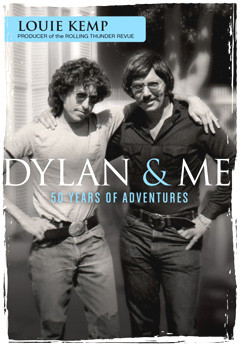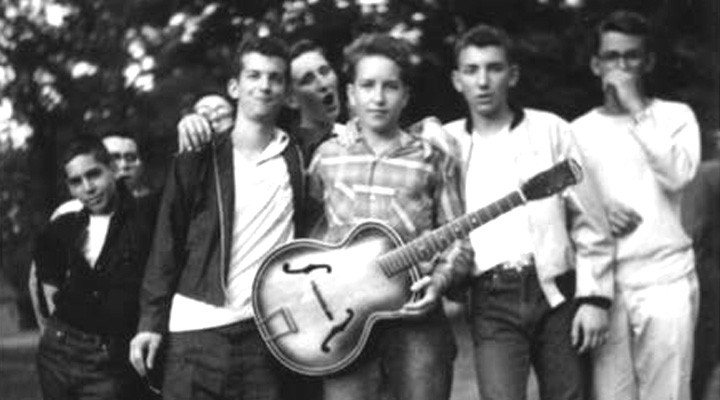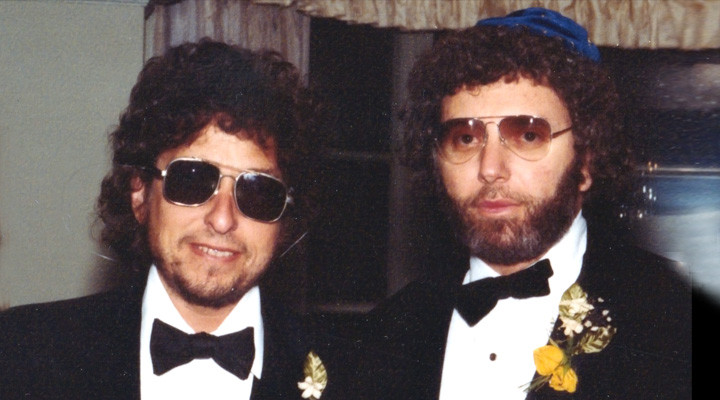 Iran’s Attack on Israel
Iran’s Attack on Israel


11 min read
A fascinating new book explores Louie Kemp’s 50-year friendship with the music legend.
 What happens when your best friend from childhood becomes a global superstar? In his newly-released memoir, Dylan & Me – 50 Years of Adventures, Louie Kemp chronicles how two Jewish boys from rural Minnesota met at Jewish summer camp in 1953. "Bobby Zimmerman was 12 years old and had a guitar,” writes Kemp. “He would go around telling everybody that he was going to be a rock-and-roll star. I was 11 and I believed him."
What happens when your best friend from childhood becomes a global superstar? In his newly-released memoir, Dylan & Me – 50 Years of Adventures, Louie Kemp chronicles how two Jewish boys from rural Minnesota met at Jewish summer camp in 1953. "Bobby Zimmerman was 12 years old and had a guitar,” writes Kemp. “He would go around telling everybody that he was going to be a rock-and-roll star. I was 11 and I believed him."
The two remained close buddies, and at age 19 Bobby Zimmerman headed off to New York to become folk hero Bob Dylan, while Kemp took over his father’s highly-successful seafood company.
Over the course of 50 years, Kemp enjoyed an "all-access pass" to Dylan's life as a trusted ally and friend, sharing together their hopes and disappointments, triumphs and difficulties. Kemp produced Dylan’s epic 1974 tour, "Rolling Thunder Revue," and Dylan served as "best man" at Kemp's wedding (coaxed into a tuxedo at the groom’s request).
“We remained true to those young boys from northern Minnesota,” says Kemp of their lifelong camaraderie. “We laughed at the same jokes, and confided our deepest thoughts and fears. We never needed anything from each other, but have always been there for each other... We always felt safe with each other in the way that only the closest of friends can. When one of us has needed a dose of truth, we've always known who to turn to.”
 1957, at Jewish summer camp: Bobby Zimmerman with guitar. Louie Kemp to his right.
1957, at Jewish summer camp: Bobby Zimmerman with guitar. Louie Kemp to his right.
Beyond the sold-out concerts and private jets, Dylan & Me takes readers inside the songwriter’s spiritual journey. "Bobby always felt a strong connection to spirituality,” says Kemp. "He described people as ‘spirits dressed up in a suit of skin’," and he told Rolling Stone magazine: "I've always thought there's a superior power, that this is not the real world and that there's a world to come."
In the late 1970s, a friend invited Dylan to a series of Bible classes which took a decidedly Christian turn, pushing Dylan deep into the New Testament. Meanwhile, Kemp had become a Shabbat-observant Jew. “Nearly every day, Bobby and I would engage in intense discussions of theology,” Kemp recalls. “But I soon realized I didn't have a deep enough knowledge of my faith to counter Bobby's arguments.”
Kemp phoned Rabbi Manis Friedman, a Chabad educator in Minnesota, and asked him to fly to Los Angeles to teach Dylan “the Jewish version of the meaning of life.”
Kemp’s mission was to help Dylan find the spiritual fulfillment his soul was yearning for.
“It had become my mission to help Bobby find the spiritual fulfillment his soul was yearning for in Judaism – the religion of his ancestors,” Kemp writes. “I would introduce many more rabbis and observant Jews to Bobby, each bringing with him a brick to strengthen the foundation of his faith.”
Beyond these reflections, Kemp’s memoir includes some zany tidbits – like the time in summer camp the two pals raided a rival cabin with shaving cream, then “escaped” by taking a counselor’s car for a joy-ride. Or the time that Dylan traded an old sofa for an original Andy Warhol painting now valued at $60 million.
Then there’s the time that Kemp arranged for film legend Marlon Brando to join Dylan at a Passover Seder. At one point, the person leading the Seder asked Brando, who is not Jewish, to read a passage from the Haggadah. As Kemp describes, Brando obligingly delivered the passage "as if he were performing Shakespeare on Broadway." After the Seder, Brando told Kemp how inspired he was to see people that gathered together every year, all over the world, to thank God and celebrate an event that took place more than 3,000 years ago.
 Bob Dylan (L) and Louie Kemp, 1972
Bob Dylan (L) and Louie Kemp, 1972
In 1974, at the height of Dylan’s superstardom, he called Kemp with an original idea for a concert tour: Instead of flying in private jets and playing giant stadiums, why not travel by bus from town to town, playing in small, intimate venues – maintaining spontaneity by announcing the performances just a few days in advance.
Kemp liked the idea, and then Dylan dropped the bomb – asking Kemp to produce the tour. "Louie, you're a successful businessman,” Dylan said. “If anybody can pull this together, it's you."
The subsequent "Rolling Thunder Revue" became the stuff of legends, with dozens of artists including Ringo Starr, Joan Baez, and Joni Mitchell joining in the experiential four-hour shows. All the while, as Kemp criss-crossed America with the tour, he managed to juggle his “day job” at the seafood company. (A documentary about the tour, directed by Martin Scorsese, was released in June 2019.)
Bob's drive to write songs that mattered was born in part from his roots as a Jew.
Through it all, a Jewish element always remained. Reflecting on Dylan's lyrical themes, Kemp observes: "Supporting the underdog is virtually second nature to Jews because we have so often been in that position ourselves. We seem to have a sixth sense when it comes to persecution, discrimination, and injustice... There's no question in my mind that Bob's drive to write songs that mattered was born at least in part from his roots as a Jew.”
Indeed, Dylan’s songs from the 1960s such as "Blowin' in the Wind," "The Times They Are a-Changin'," and “Like a Rolling Stone” became anthems of the civil rights and anti-war movements. His much-heralded "Neighborhood Bully" was written in defense of Israel:
The neighborhood bully just lives to survive,
He's criticized and condemned for being alive...
He's always on trial for just being born.
 1975, backstage in San Francisco (L to R): concert promoter Bill Graham,
1975, backstage in San Francisco (L to R): concert promoter Bill Graham,
actor Marlon Brando, and Louie Kemp
In the book’s acknowledgements, Kemp thanks the founder of Aish HaTorah, Rabbi Noah Weinberg zt”l. Though it does not involve Bob Dylan and thus is not in the book, Kemp shared with Aish.com details of how he became one of Rabbi Weinberg’s beloved partners.
“In December 1985, I was home in Duluth, Minnesota, and got a phone call from Aish’s Yona Yaffe to say that Rabbi Weinberg would like to come spend Shabbos with me. I had not met Rabbi Weinberg but I’d heard a lot of amazing stories about him.
“I laughed and said that Rabbi Weinberg was welcome for Shabbos, but that it was minus-20 degrees with an even-colder wind-chill factor, and lots of snow piled high.” (Mark Twain famously said, "The coldest winter I ever spent was a summer in Duluth.")
Though Kemp offered to meet in balmy Los Angeles, Rabbi Weinberg preferred coming to Duluth. “He seemed like my type of person,” Kemp says. “He was not afraid of the elements, and was a man on a mission not easily deterred.”
Rabbi Weinberg was enthralled with the white mist as Lake Superior froze over.
Rabbi Weinberg arrived at Kemp’s mansion on the shores of Lake Superior, the largest lake in the world, which was in the process of freezing over. A white mist emanated from the lake, along with the crackling sound of ice being formed. Rabbi Weinberg was enthralled and asked Kemp to borrow outdoor gear: long underwear, sweater, hat, gloves, and boots. With Kemp watching from his warm home, Rabbi Weinberg walked down to the lakeshore, then climbed atop a gazebo to survey the lake’s mystical vision.
“Seeing Rabbi Weinberg’s spiritual depth and appreciation of nature was the first of many insights I would learn from him over the coming years of our friendship,” says Kemp.
Toward the end of Shabbos, in which Rabbi Weinberg generously shared his vast Torah knowledge, Kemp’s curiosity finally got the best of him and he blurted out: “Rabbi, I’m thrilled you’re here – but why Duluth in December?!”
Rabbi Weinberg smiled and said, “I have a plan to save the Jewish people and I need your help.” He went on to explain that Aish had developed the Discovery seminar, exploring the rational basis for belief in Judaism. A team in Jerusalem, headed by Rabbi Motty Berger, was ready to present the inaugural seminar – a 3-day Discovery weekend for 150 people at a Palm Springs resort hotel. All that was needed was funding.
After Shabbos, Kemp wrote a check to cover full cost of the weekend seminar, and promised to bring along a few friends to Palm Springs. Kemp told Rabbi Weinberg: “If it’s half as good as you say, we’ll fund the rest of it.”
At the Palm Springs weekend, Kemp witnessed how Discovery succeeded in changing participants’ attitudes – breaking their misconceptions and inspiring them to study Torah wisdom. Convinced, Kemp wrote a check for $150,000 to expand Discovery to 15 U.S. cities.
Since then, over 100,000 people worldwide have participated in Discovery, influencing untold numbers to become more Jewishly committed. Says Kemp: “Sponsoring Discovery was one of the best choices I ever made.”
Over the years, Rabbi Weinberg would fondly refer to Kemp as “the father of Discovery.” On one visit to Rabbi Weinberg’s office overlooking the Western Wall, he told Kemp: “The merit of all those who’ve attended the Discovery Seminar is credited to your heavenly account.” Rabbi Weinberg then grasped Kemp’s hands, and together they danced in joyous celebration over this great eternal reward.
And it all started at a wintry Shabbos in Duluth.
Kemp, now 77, reflects on what made his friend Bob Dylan so successful, including his unprecedented receipt of the 2016 Nobel Prize in Literature:
 1983: Bob Dylan (left) as the best man at Lou Kemp's wedding
1983: Bob Dylan (left) as the best man at Lou Kemp's wedding
"Some wonder why the Jews have been so successful in so many areas, including the arts. I believe it’s at least in part because the quest for knowledge, meaning, and truth are ingrained in Jewish culture. We have a passion to seek out meaning and give it new expression, both morally and artistically. That drive – along with another Jewish trait known as chutzpah – have always been strong in Bobby, and his gifts have made his expression worthy of the ages.”
In one amusing story, Kemp recalls the time he and Dylan attended Yom Kippur services in Santa Monica, California:
We had been there before, and the rabbi recognized Bobby right away. But few if any of his fellow worshippers – all somberly dressed – realized he was standing at the back of the room. Having, as usual, missed the memo regarding the dress code, Bobby was wearing cowboy boots, torn jeans, a hoodie, a black leather jacket, and what looked like a long-lost pair of Jackie Kennedy's sunglasses.
Specifically, he was attending the closing service of the day, Neilah... The Ark housing the holy scrolls of the Torah remains open for the entire service, and it is considered a great honor to be chosen by the rabbi to open it. This carries with it many blessings for the new year. The honor customarily goes to the temple's most generous donor – but not this time.
With his ancient eyes, Rabbi Levitansky scoured the congregation. At last, his gaze came to rest upon a solitary figure standing in the back of the room. He motioned the casually dressed fellow up to the pulpit, and up he came. Bob Dylan opened the Ark on Yom Kippur.
Afterward, when the last echo of the shofar had diminished to silence and most of the congregants had trickled away, the synagogue's biggest donor pulled the rabbi aside. "I want you to know, Rabbi," said the man, "that when you didn't call me up to open the Ark, I was quite hurt. Then I saw whom you chose and I realized you were even wiser and kinder than I'd imagined. So I'm going to double my contribution for the coming year. It takes a great and generous heart to give the honor of opening the Ark for Neilah to a homeless Jew."
In the end, Dylan & Me is not a biography, nor an analysis of Dylan’s songs and their impact. What sets it apart from the endless other books about Dylan is that it’s not based on third-party interpretations, speculations, or unconfirmed rumors. Rather, it is an eyewitness account by someone who knows Dylan… better than anyone else who has tried to explain Dylan to the rest of us.
Kemp says: “My friend has always been Bobby Zimmerman, not the legend ‘Bob Dylan’. We’re just two regular friends who would talk for hours like other friends... except that to the rest of the world, one of us happened to be Bob Dylan."
